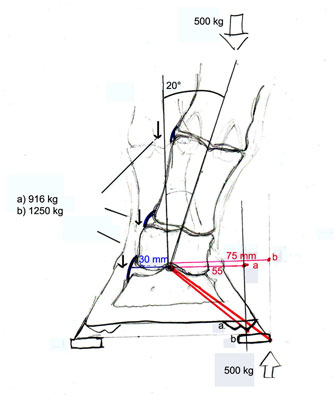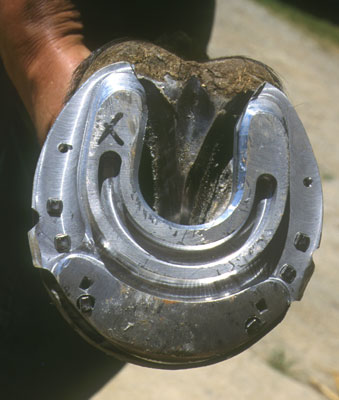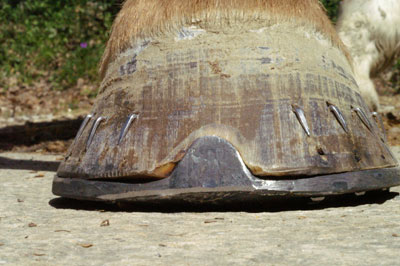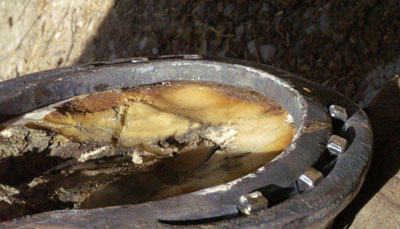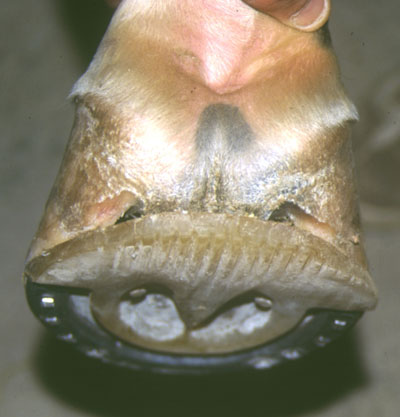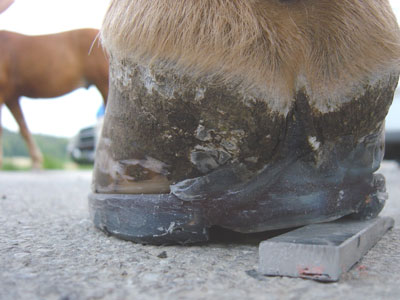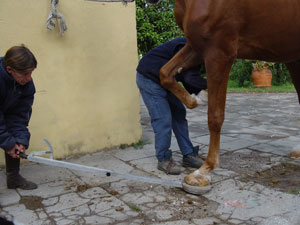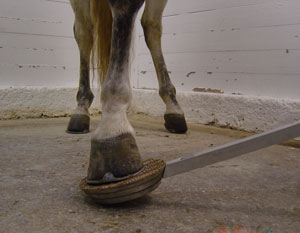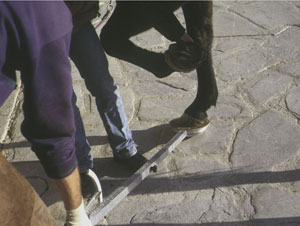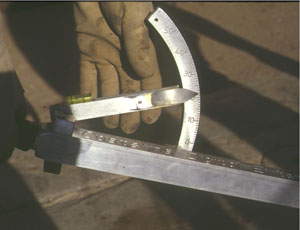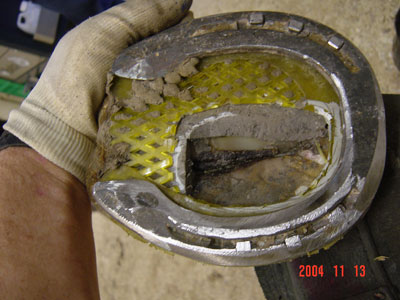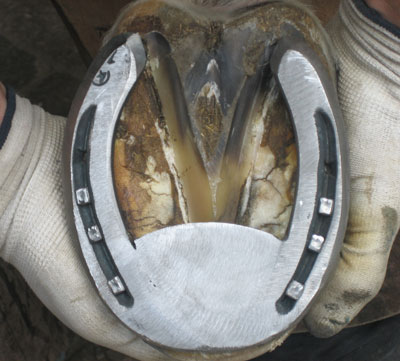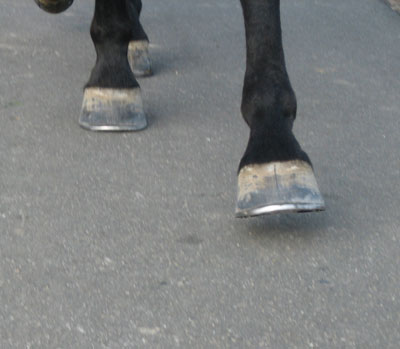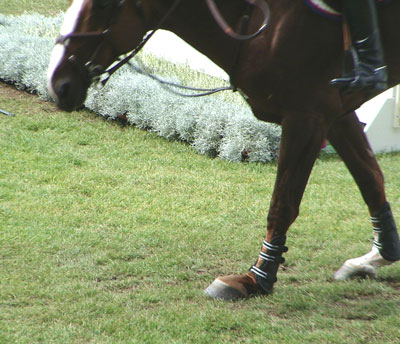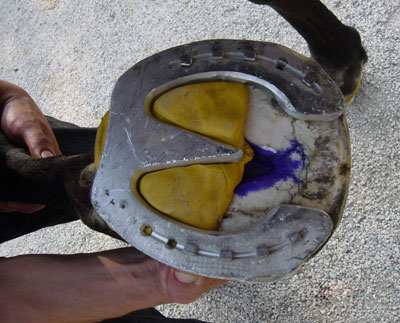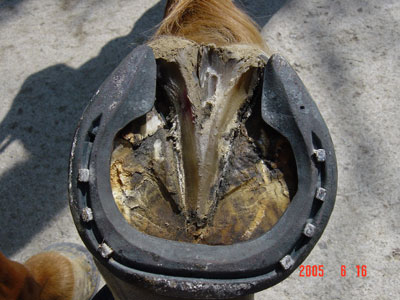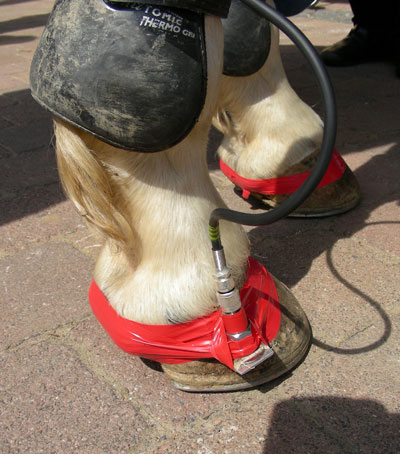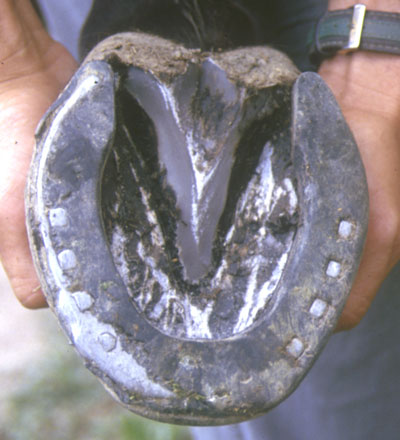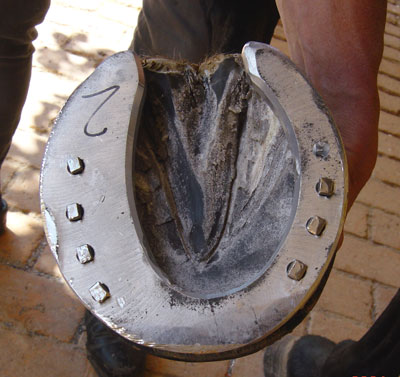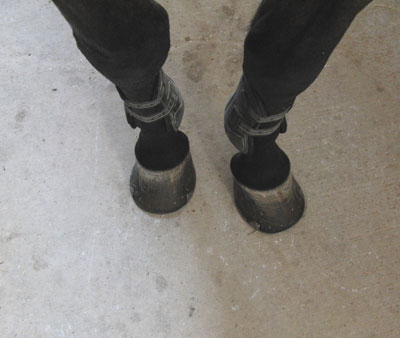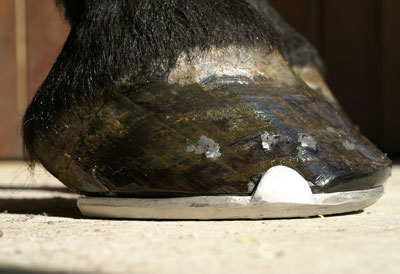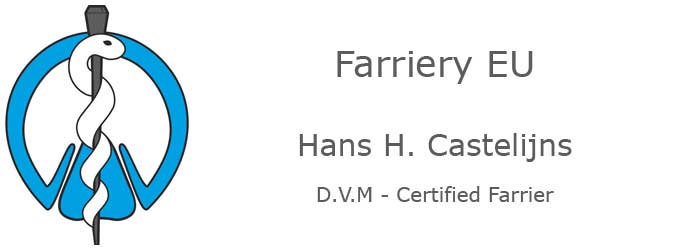
Special and Therapeutic Shoeing, a Rational Approach |
||||||||||||||||||||||||||||||||||||
1 .Introduction |
||||||||||||||||||||||||||||||||||||
It is the author’s conviction that, except for particular severe foot conditions like founder, “the foot tells us how it should be trimmed”, as described by M. Savoldi [1]. In other words, if for therapeutic or performance reasons we want to modify the hoof-shoe combination, there is a not a lot of leeway in the trim of a particular foot, while the applied shoe type, placement and adjustments give us endless possibilities. A practical example of this principle is therapeutic shoeing for podotrocleosis (Navicular syndrome, palmar hoof pain). In the typical patient, dorsal extension of the affected limb will be limited due to the pathology. Theoretically it makes sense to limit the hyper extension of the distal inter-phalangeal joint by leaving the heels longer. [2] In practice however, we get upward displacement of the walls at the heels [3], a shorter, often underrun, solar surface of the palmar part of the hoof, more heel wear on the branches of the shoe and a different stance of the horse as seen from the side, with the horse placing his front limbs further back, under itself. The same case can be treated without these “collateral” effects by trimming the heels to the widest part of the frog, as previously discussed, and then shoeing at short, regular intervals with a shoe which facilitates dorsal break over (blunt, set back toe, reverse shoe, rockered toe etc.). |
||||||||||||||||||||||||||||||||||||
2. General Principles |
||||||||||||||||||||||||||||||||||||
No matter what the final performance or therapeutic aim, some general principles apply to all or most shoe applications: - Only shoe when necessary, that is when wear and tear are more than the hoof can bear, or when shoes are part of necessary treatment, or when horses need shoes for traction. - The trim is the most important part of a shoeing job; flares and sheared heels should be corrected. The hoof should be short and proportioned, as it will only grow longer and forwards before the next shoeing. - The shoe should be shaped to the foot, or in any case the nail holes should correspond to the white line; nail too coarse and the result may be compression or infection of the solar, white line, or laminar corium; nail too fine and the wall will break apart over time. - Choose the appropriate materials: The choice of shoe depends on the horse, hoof shape and quality (like hoof wall thickness), type of work and footing. There is no single shoe type which is appropriate for all horses and all disciplines. The type of nail depends on the type of shoe, hoof quality and type of work but in any case the type, number and placement of nails should assure that it is the weakest link; in the case of shoe loss no part of the wall should come away with the shoe. - The best shoeing job looks and works awful if the shoes are left on too long. Respect shoeing intervals first and foremost and allow for appropriate shoe width and length at the heels, as the foot grows forward and widens between shoeing appointments. After a reasonable shoeing interval the shoe should still cover the wall at the heels. |
||||||||||||||||||||||||||||||||||||
3. Performance, prevention, therapy. |
||||||||||||||||||||||||||||||||||||
A detailed discussion on the relationship between performance and shoeing is outside the scope of this publication. Shoeing influence on performance is closely related to the disciple the horse is used in. Examples are gaited horses (e.g. Icelandic, Tennessee Walking), trotters and pacers. If a racing trotter has a tendency to pace during acceleration, the three shoeing modifications which might prevent this are: heavier shoes, longer toes or more grip. None of these are necessarily very healthy. Sometimes the equine practitioner is called upon to rein in the excessive enthusiasm of trainer and farrier for extreme solutions, perceived as being performance enhancing. The definite argument being that a lame horse will not perform at all. Prevention is related to both discipline and therapy as some sports are associated with specific injuries and prevention of (re)injury is better than (re)treating a lameness. |
||||||||||||||||||||||||||||||||||||
4. Therapeutic shoeing ways and means. |
||||||||||||||||||||||||||||||||||||
The basic therapeutic shoeing means at the disposal of the equine podiatrist are: 1) Break over modifications, e.g. rockered toe. 2) Ground surface modification of the shoe, e.g. egg bar shoe 3) Modifications of hoof support and weight bearing, e.g. the use of hoof packing or of a heart bar. 4) Shock absorbing shoeing (pads, plastic shoes). 5) Weight reduction, e.g. aluminum shoes. 6) Hoof wall defect stabilization e.g. quarter crack repair with patches, glue on shoes. Of course most of these means can be, and often are, combined in the treatment of a specific pathology. |
||||||||||||||||||||||||||||||||||||
4.1 Break over modifications. |
||||||||||||||||||||||||||||||||||||
Dorsal break over is defined as the moment the heels lift off the ground in the last part of the stand phase. In the horse moving straight, with normal conformation and on flat hard surface the fulcrum (break over point) is not the center of the toe, but slightly lateral of this point [4], at least on the front feet. In a limb which presents conformation abnormalities, like axial rotations or angular deviations, the point of break over will vary, even when moving on a straight line on flat hard ground. Thus, a toed out conformation will cause the point of break over to change towards the center, or even the medial part of the toe. Even more markedly, a toed in horse will clearly break over the outside toe. On deep ground, the same force pulling the distal phalanx out of its most extended position into flexion, that is the deep digital flexor tendon, will find less resistance as the toe of the shoe can “roll” into the ground. [Fig.01] |
||||||||||||||||||||||||||||||||||||
|
||||||||||||||||||||||||||||||||||||
When a horse is turning or when it travels on uneven ground, the fulcrum is again modified; on a right hand turn, the left fore will break over at the medial toe, the right fore over the lateral one. On an individual horse, the average point of break over is worn of the ground surface of the shoe, at a specific area of the toe. It is good, preventive farriery practice to roll or rocker the toe at this same point on the new shoe. [Fig.02] |
||||||||||||||||||||||||||||||||||||
|
||||||||||||||||||||||||||||||||||||
The anatomical structures which are solicited most in the last part of the stance phase, just prior to break over are: The deep digital flexor tendon, its accessory ligament (inferior check ligament), the collateral ligaments of the distal sesamoid, the navicular bursa, the impar ligament, the dorsal laminae, the dorsal aspects of the carpal joints, but also the dorsal margins of the distal inter phalangeal joint. When the last phase of the stance phase occurs on a sharp turn, like a show jumper changing direction towards the next obstacle, the collateral ligaments of the navicular bone, DIP, PIP joint, metacarpo phalangeal joint and even the suspensory branch opposite to the side of the turn, are stressed, as is the subcondral bone of the joints on the side of the direction change. [Fig.03 a,b] |
||||||||||||||||||||||||||||||||||||
|
||||||||||||||||||||||||||||||||||||
Facilitating dorsal break over can be done by setting back the shoe, relative to the toe of the trimmed hoof, blunting the toe of the shoe, rolling the ground surface of the shoe in the toe area, rockering it or a combination of all three. [Fig 04] |
||||||||||||||||||||||||||||||||||||
|
||||||||||||||||||||||||||||||||||||
Facilitating sideways break over can be done by choosing shoes with a narrowed ground surface all around their perimeter, like some concave shoes, half round section shoes, or full rolling motion shoes. [5] [Fig 05] |
||||||||||||||||||||||||||||||||||||
|
||||||||||||||||||||||||||||||||||||
A simple and very effective way to facilitate dorsal, lateral and medial break over, is the “French Rockered Shoe”. In the French (and Swiss) tradition, sport horses are routinely shod with a rocker, which starts at the second or even third nail hole and goes around the toe, all the way to the opposite toe or even quarter. In this type of rockered shoe, the inside ground edge of the shoe should still be on the anvil (or ground of the shod foot). The dorsal part of the shoe does therefore look like a dish or bowl. Apart from offering multi directional ease of break over, this shoeing method also gives sole relief (as the inside foot edge of the shoe is forged down) and improves nail pitch. [Fig.06 a,b] |
||||||||||||||||||||||||||||||||||||
|
||||||||||||||||||||||||||||||||||||
Flexible shoes like plastic shoes or flaps [Fig.07]. Also maintain vertical flexibility in the hoof, absorbing a few degrees of the inclination in the hoof capsule, instead of in the joints, upon a sharp direction change of the horse. [Fig.08] |
||||||||||||||||||||||||||||||||||||
|
||||||||||||||||||||||||||||||||||||
The use of a digital extension device (DED) (© 1 ), permits the exact measurement of the tolerance to dorsal extension, lateral and medial elevation (and even flexion) on the standing horse of each (front) limb on both the sound and the lame horse. [Fig.09 a,b,c,d] |
||||||||||||||||||||||||||||||||||||
|
||||||||||||||||||||||||||||||||||||
The value of this test is not so much diagnostic, as for example a reduced tolerance to dorsal extension may depend on many different lesions, but indicative of the specific type of therapeutic shoeing that will be most effective. In other words it predicts which therapeutic shoe will help. (See table 1) |
||||||||||||||||||||||||||||||||||||
|
||||||||||||||||||||||||||||||||||||
Table 1:
|
||||||||||||||||||||||||||||||||||||
A study of 250 sound horses, freshly shod or trimmed, gave the following values: Dorsal extension (mean [CI95%] = 43.18° ± 0.93°, lateral elevation (mean 18.83° ± 0.26°) and medial elevation (mean= 19.79° ± 0.32°). The SDs were 7.46°, 2.12° and 2.53° respectively. [6] To illustrate the correlation between the hypothetical result of a digital extension test and the therapeutically shoeing needs of the hypothetical patient, the following example may be useful: if the right fore lame limb shows 28° degrees of tolerance to dorsal extension, 15° of lateral elevation and 19° of medial elevation (before the opposite side of the hoof lifts off the board (Fig), the hoof of the right fore needs a therapeutic shoe which facilitates dorsal and lateral break over, for example a shoe with a setback, blunted and rolled toe and with the lateral ground surface ground away. [Fig,10] |
||||||||||||||||||||||||||||||||||||
|
||||||||||||||||||||||||||||||||||||
4.2. Ground surface modifications |
||||||||||||||||||||||||||||||||||||
As opposed to break over modifications, which have an effect both on compact and on penetrable ground (although they may be more necessary on compact ground), ground surface modifications, such as wide webbed heels, toes or branches of the shoe have most of their effect on penetrable ground. A wide webbed toe, narrow heeled shoe [Fig.11], prevents the toe from sinking into the ground at the mid stance phase in deep footing, but on hard ground a normal shoe (placed in the same position) will do the same. Or to give an example in the opposite sense, an egg bar shoe will prevent heel sinking, relative to a normal shoe, only on penetrable ground. |
||||||||||||||||||||||||||||||||||||
|
||||||||||||||||||||||||||||||||||||
On penetrable footing, the modifications of the ground surface of the shoe (and its placement relative to the trimmed foot) will change the center of ground reaction force in all three moments of the stance phase, sometimes with unintended consequences. At speed, horses land heel first, soliciting the back part of the foot and its shock absorbing function, but also the digital extension tendon and its distal insertions. [Fig.12] In the mid stance phase, with the fetlock at maximum extension, the suspensory ligament and the superficial digital flexor tendon are at peak tension. [Fig.13] |
||||||||||||||||||||||||||||||||||||
|
||||||||||||||||||||||||||||||||||||
At the end of the stance phase, just before break over, the deep digital flexor tendon (and other previously discussed structures) will be at peak stress. [7] Thus, an egg bar shoe with a setback blunted toe, will favor the sinking in of the toe on penetrable footing, facilitating break over, relieving the deep digital flexor tendon. On the other hand, in the mid stance phase, it might solicit the suspensory ligament and superficial digital flexor tendon more. On landing, the palmar part of the egg bar will cause more of a pull on the distal insertion of the digital extension tendon. Briefly put, “there is no free lunch”; when relieving one anatomical structure, during a particular phase of the stance, other structures will be charged more in the other stance phases. 4.3 Modifications of hoof support and weight bearing. One of the drawbacks of a classical, nailed on, open shoe, is that it distances the sole, frog and part of the bars from the ground, thereby reducing the weight bearing parts of the hoof to the walls, and ultimately to the laminar suspensory apparatus. Many hoof conditions, such as weak and under run heels, hoof wall defects, laminitis, etc. can benefit from recruiting the bars, frog, or parts of these, into weight bearing. Special shoes which have this function are the heart bar and the onion heel shoe, which respectively recruit the frog and the bars into weight bearing. [Fig. 14, 15] |
||||||||||||||||||||||||||||||||||||
|
||||||||||||||||||||||||||||||||||||
Specialty pads, with or without fast setting hoof packing materials, can also have this function, besides having shock absorbing properties. Sole packing materials are distinguished by different hardness (expressed in shore on the A scale), chemical composition, weight, wear resistance, setting times, adhesiveness to the sole, ability to perspire and application method. Some of the currently available products and their properties are listed in table 2: Properties of some commercially available sole packing materials: [8] |
||||||||||||||||||||||||||||||||||||
Table 2 |
||||||||||||||||||||||||||||||||||||
Pads and sole packing can also be used to protect thin soles against bruises, especially the softer, light weight ones. When applying a sole packing, it is useful to do a check on the tolerance to pressure of the frog, remembering that the overlaying structures include the digital cushion, deep digital flexor tendon, navicular bursa and distal sesamoid, all of which can be inflamed and painful, as also a thrushy frog. This check can be done with hoof testers, or by placing the frog on a wooden handle and lifting up the opposite foot. A positive (pain) reaction should counsel the use of soft packing material. |
||||||||||||||||||||||||||||||||||||
4.4 Shock absorbing shoeing. |
||||||||||||||||||||||||||||||||||||
Shock and high frequency vibrations are implicated in pain, ischemia and osteo articular degeneration, similar to “white finger syndrome” in humans. A useful clinical sign is when the horse is uncomfortable with the hammer blows, while driving the nails when setting a shoe. Horses which often benefit from shock absorbing shoeing are those that are called upon to work on hard surfaces, like harness or carriage horses. Shock absorption can be achieved by interposing pads and sole packing between the shoe and the hoof, or with specialty shoes which absorb shock on the ground surface. In the first case it is important to drill holes in the pad, in correspondence to the nail holes of the shoe, before nailing the shoe/pad combination to the foot, so as to preserve the micro movement of the pad independently from the nails. [Fig 16] |
||||||||||||||||||||||||||||||||||||
|
||||||||||||||||||||||||||||||||||||
The farriery industry is constantly coming out with specialty shoes with shock absorbing claims, but objective, comparable data (at least to the bare foot and normally steel shod foot) are often lacking. For many fast disciplines (racing, eventing etc.) many of these products are too bulky and/or too heavy. For working day horses, excessive wear and/or cost is also often a problem. [Fig.17] |
||||||||||||||||||||||||||||||||||||
|
||||||||||||||||||||||||||||||||||||
An interesting solution is offered by products that have a rigid half shoe or metal insert at the toe, for stable nailing, and shock absorbing flexibility in the heel area, like “flaps”, Epona© shoes etc., as they preserve vertical mobility at the heels. [Fig.07] |
||||||||||||||||||||||||||||||||||||
4.5 Weight reduction |
||||||||||||||||||||||||||||||||||||
Light weight shoes, mainly aluminum alloy, are used for performance (flat racing etc.), but also have other, preventive and therapeutic properties. Aluminum alloys absorb high frequency vibrations better than steel on hard, compact ground [17], offer better grip on this type of surface and cause less fatigue. They also make it possible to have asymmetrical, wide web, or bar shoes, without excessive (asymmetrical) weight increase and they diminish the limb’s deviations from the normal flight arch. [Fig. 18] |
||||||||||||||||||||||||||||||||||||
|
||||||||||||||||||||||||||||||||||||
Medial or lateral deviations, out of the sagittal plane, of the flight arch of the shod hoof, are common in horses which respectively toe out or in, which in the first case often causes interference injuries to the contro lateral limb. [Fig.19 a,b] |
||||||||||||||||||||||||||||||||||||
|
||||||||||||||||||||||||||||||||||||
Weight reduction also reduces hyper flexion (and extension) of the limb in the air between stance phases, which might benefit patients with articular (fetlock and carpus e.g.) and tendon or suspensory ligament lesions. |
||||||||||||||||||||||||||||||||||||
4.6 Hoof wall defects stabilization, repair and glue on shoes. |
||||||||||||||||||||||||||||||||||||
Many severe hoof conditions can be successfully treated with these materials and methods. It is now possible to glue on almost any type of shoe directly to the horse’s hoof, and there are also several cuff type shoes available, specifically designed for nail less shoeing. The application of glue on shoes is use full in foals, on damaged feet ,very thin walled and thin soled hoofs and whenever nailing is risky or painful. |
||||||||||||||||||||||||||||||||||||
5. Conclusion |
||||||||||||||||||||||||||||||||||||
In most cases therapeutic farriery depends on a correct trim (which is not necessarily the easiest part of farriery), as leaving extra length at one side of the hoof, at the heels, or at the toe, will lead to hoof capsule distortion. It is then, that the type, placement and modifications of the shoe will make the (therapeutic) difference. In lame horses, using a digital extension test may give valuable information as to the most appropriate type of shoe for the specific lameness, as it will let the horse “speak for itself”. This is especially important, as our diagnostic capabilities have become more precise, often resulting in multiple diagnostic findings in the same limb, many of which might not be the cause of pain or diminished function. When choosing the therapeutic features of the shoe/shoeing, it is useful to keep the type of horse, hooves, conformation, work and surface on which the horse works in mind. The latter is very important, as the therapeutic shoe/ground interaction is often at the heart of the success or failure of the intended podiatry treatment. |
||||||||||||||||||||||||||||||||||||
References: |
||||||||||||||||||||||||||||||||||||
[1] Savoldi, M.T.; “Identifying the true foot of the horse”, proceedings, 10 th Geneva Congress of Equine Medicine and Surgery, 11-13 December 2007, pp. 63-67. [2] Lawson, S.E.M.; Château, H.; Pourcelot, P.; Denoix, J.M. ; Crevier – Denoix, N. ; “Effect of toe and heel elevation on calculated tendon strains in the horse and the influence of the proximal interphalangeal joint”, J. Anat. (2007) 210, pp. 583-591. [3] Castelijns, H.H.; “Pathogenesis and treatment of spontaneous quarter cracks – quantifying vertical mobility of the hoof capsule at the heels”, Pferdeheilkunde, 22 Jahrgang, 2006, Ausgabe 5, September – Oktober, pp. 569-576. [4] Van Heel, M.C.V., Barneveld, P.R., Van Weeren, P.R., Back, W.; “Dynamic pressure measurement for the detailed study of hoof balance; the effect of trimming”., Equine Vet. J. (2004) 36 (8), pp. 778-782. [5] Serteyn, D., Vanschepdael, P., Caudron,I., Miesen, M., Lalot, P., Grülke, S., Staquez, S.; “Evaluation Clinique de la ferrure orthopédique Equi+® Lors de pathologies de l’articulation interphalangienne distale”, Pratique Vétérinaire Equine, 1995, 27 (2), pp. 105-110. [6] Castelijns, H.H. ; "How to Use Digital Extension Device in Lameness Examinations », 2008, Vol. 54/AAEP Proceedings, pp.228-231. [7] Van Heel, M.C.V., Van Weeren, P.R., Back, W.;”Shoeing sound Warmblood horses with a rolled-toe optimizes hoof unrollment and lowers peak loading during break over”. Equine Vet J. 2005. [8] Castelijns, H.H.; “Sole and frog support systems”, proceeding 11 th SIVE Congress, 28-30 January 2005, pp. 52-55. [9] Benoit, P., Barrey, E., Regnault, J.C., Brochet, J.L.; “Comparison of the Damping Effect of Different Shoeing by the Measurement of Hoof Acceleration”, Acta ANAT. 1993, 146, pp. 109-113. |
||||||||||||||||||||||||||||||||||||
Commercial names and products appearing in the text: (© 1) Colleoni srl. Via Boscaccio, 40, 21012 Cassano Magnano Varese – Italy. (© 2) podoquinometrique; Alliot & Pérès Associés, Equine Biomeanic Data Thecnology, www.sidetechnologies.fr.gd (©3) Epona shoes; www.EponaShoe.com |



